How to create a custom Java-based REST endpoint
This page provides guidelines and best practice recommendations on how to create a custom Java-based REST endpoint with Magnolia.
Java-based custom REST endpoints give access to the full power of Java and provide a high level of flexibility and configurability. REST endpoints in Magnolia also allow fine-grained security.
Endpoints can be used for many purposes, from triggering a third party service to implementing a custom JSON provider. However, there are also other possibilities to get Magnolia content as JSON.
In this page, we assume that you know Java and the basics of Maven or another similar dependency management tool.
What is a Magnolia REST endpoint?
A REST endpoint is a resource located on a server, in our case on a Magnolia instance, which can be accessed with a RESTful URL.
A Java endpoint makes use of the Java API for RESTful Web Services (JAX-RS). The endpoint exposes public methods accessible via distinct URLs. A public method is accessed with a request and produces a response.
Magnolia REST endpoints are JAX-RS endpoints.
REST base path and RestDispatcherServlet
The base path for every Magnolia REST resource is /<context>/.rest,
where <context> is either the name of the webapp or / if the webapp is
served from the root context. For details about specific paths of
specific REST resources, see Understanding
@Path below.
All requests to /<context>/.rest* are handled by
info.magnolia.rest.RestDispatcherServlet, which is
installed and configured by the
magnolia-rest-integration module.
What do endpoints do?
An endpoint can have several methods accomplishing completely different tasks. Basically endpoints can do anything that is possible with Java.
Each publicly exposed method representing a REST resource must produce a
response that contains at least some response headers (the minimum is a
proper HTTP
response code). Both the request and response may or may not contain a
payload (JSON or XML) wrapped in the request or response body.
An endpoint should implement at least one method that can be accessed by
its specific path with one of the standard HTTP methods: GET, PUT,
POST or DELETE.
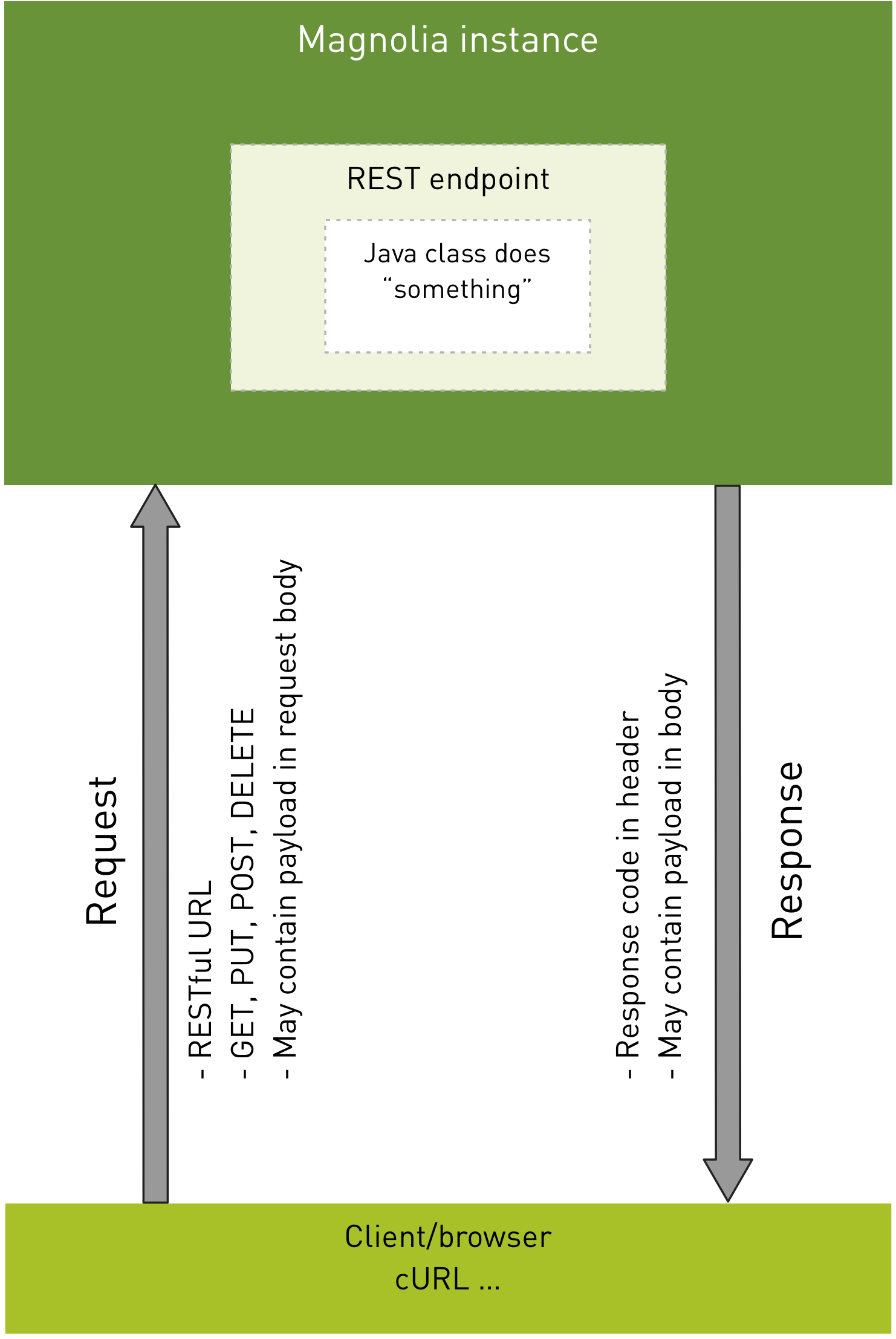
Data API endpoints
A typical use case for an endpoint is a data API, which can read,
create, update or delete content. A data API endpoint must implement at
least one method, such as a GET method to read data.
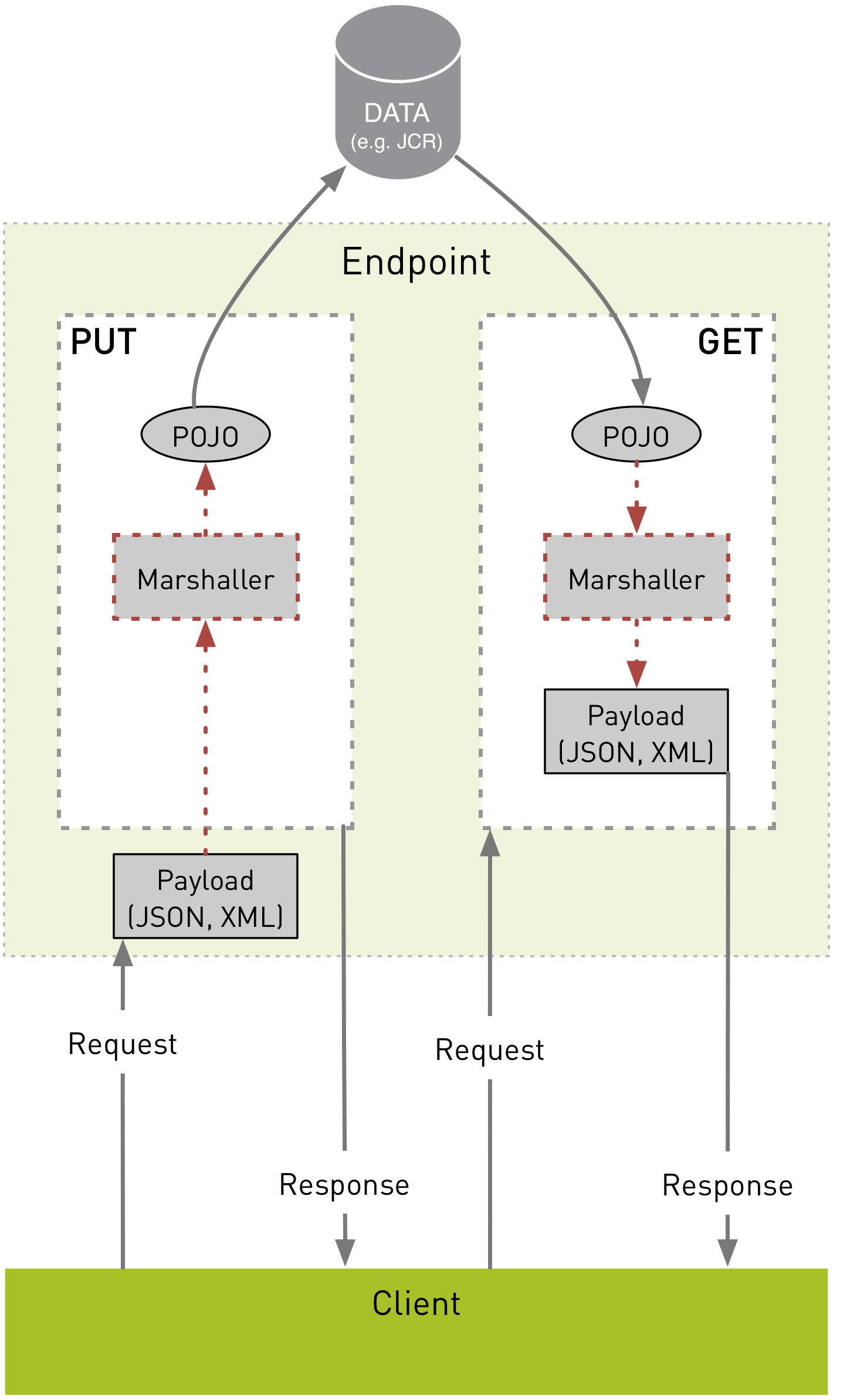
Typically, methods for data interaction are called with these HTTP methods:
Data interaction function |
Read data |
Create data |
Update data |
Delete data |
HTTP Method |
|
|
|
|
Request has payload |
no |
yes |
yes |
no |
Response has payload |
yes |
maybe |
maybe |
no |
Magnolia provides default endpoints to read, create, update and delete
nodes and properties of JCR workspaces. For details about the Magnolia
default JCR content API, read the section about the
magnolia-rest-services module below or
have a look at the Delivery API page.
Java, Maven and package names
Java classes typically are wrapped in modules. When the Java classes of your endpoint are part of a (Maven) module, you can add the module to your bundle or webapp as a .jar file or manage the dependency with Maven in the POM file of the webapp.
Wrap your Java REST endpoint within a Magnolia Maven module.
Creating a Magnolia Maven module with a Maven archetype
Use the Magnolia Maven archetype to create a new Magnolia Maven module that will host your Java REST endpoint.
If you are not familiar with the Maven archetype plugin, please read How to use Magnolia Maven archetypes: The archetype plugin.
Here is the archetype command call:
mvn archetype:generate -DarchetypeGroupId=info.magnolia.maven.archetypes -DarchetypeArtifactId=magnolia-module-archetype -DarchetypeVersion=RELEASE
|
Java package name
Add the Java class, which represents the REST resource, to a package with a name that allows versioning of the REST resource. Typically, the last part of the package name should indicate the version.
package com.example.rest.service.v1;
@Path("/demo/v1")
public class DemoEndpoint {
/* more code to be added here later on */
}In this example:
-
The package name is
com.example.rest.service.v1. -
The class name is
DemoEndpoint. -
The fully qualified class name (fqcn) is
com.example.rest.service.v1.DemoEndpoint.
If you want to raise the version of the endpoint later on, without
disabling the original version, create a package with a higher version
such as com.example.rest.service.v2.
Magnolia REST modules and recommended dependencies
We assume that you know the basics about how to manage dependencies, and that you manage these dependencies with Maven.
The Java API for RESTful Web Services - JAX-RS is defined in the packages javax.ws.rs and javax.xml.bind. These are interfaces and sufficient
for endpoint classes during compilation. However, on runtime, when the
REST resources are used, a webapp also requires implementations of the
these two mentioned packages. Magnolia uses
RESTeasy for this purpose.
The dependencies (for both the interfaces and the implementations) are
managed by the magnolia-rest-integration module.
Depend on the Magnolia REST modules. This ensures that you use the same versions of JAX-RS interfaces and implementation libraries as Magnolia.
You should at least depend on the magnolia-rest-integration module.
Your module, which depends on Magnolia REST module(s), automatically (transiently) inherits the dependencies from the Magnolia modules.
The Magnolia REST module contains three submodules.
Magnolia REST modules
magnolia-rest-integration
The REST Tools module integrates the swagger tools into the Admin UI. These tools ease the development and testing of REST endpoints.
The module extends the RestDispatcherServlet with a custom, API-aware
servlet that can read API annotations from all available REST endpoints.
The servlet enables the endpoints in the Swagger API explorer. If you
write your own endpoint you need to add annotations in the code
yourself.
| This is installed by default. |
magnolia-rest-services
The magnolia-rest-services module depends on the
magnolia-rest-integration module. Therefore, it provides everything
explained in the previous section.
In addition, it contains the default Magnolia REST endpoints info.magnolia.rest.service.node.v1.NodeEndpoint, info.magnolia.rest.service.property.v1.PropertyEndpoint and info.magnolia.rest.service.command.v1.CommandEndpoint, which are described on the Delivery API page.
This module also provides info.magnolia.rest.service.node.v1.RepositoryMarshaller, which you can use within your custom endpoint.
magnolia-rest-content-delivery
This module provides the Delivery endpoint.
magnolia-rest-tools
The REST Tools module integrates the swagger tools into the Admin UI. These tools ease the development and testing of REST endpoints.
The module extends the RestDispatcherServlet with a custom, API-aware
servlet that can read API annotations from all available REST endpoints.
The servlet enables the endpoints in the Swagger API explorer. If you
write your own endpoint you need to add annotations in the code
yourself.
| This is installed by default. |
The module is used for development and testing purposes only.
Magnolia REST module versions
Make sure you use the same version for all Magnolia REST modules on which you depend.
The version of the Magnolia REST modules depends on the version of
Magnolia you use to run your custom endpoint. We recommend you check the
POM file (or the parent POM file) of your Magnolia webapp. The .pom
file manages the version of the Magnolia REST modules using the property
restVersion. If you are unsure, use the latest released version, which
is currently:
2.2.34
How to create a Java class that acts as a REST resource
To create a Java class that acts as a REST resource, write a Java class
— your service — and register this service in the Magnolia
configuration workspace. Registering the service makes sure that the
REST resource can be accessed by a default Magnolia servlet.
In this section we create a simple endpoint implementation and explain some important details for every custom Java REST endpoint in the context of Magnolia.
Creating the Java class
Create the class com.example.rest.service.v1.DemoEndpoint. This is the
code for a simple working example:
package com.example.rest.service.v1;
import info.magnolia.rest.AbstractEndpoint;
import info.magnolia.rest.EndpointDefinition;
import javax.ws.rs.GET;
import javax.ws.rs.Path;
import javax.ws.rs.Produces;
import javax.ws.rs.core.MediaType;
import javax.ws.rs.core.Response;
@Path("/demo/v1")
public class DemoEndpoint<D extends EndpointDefinition> extends AbstractEndpoint<D> {
public DemoEndpoint(D endpointDefinition) {
super(endpointDefinition);
}
@Path("/hello")
@GET
@Produces({MediaType.APPLICATION_JSON, MediaType.APPLICATION_XML})
public Response hello() {
return Response.ok().build();
}
}In the example above, note that the class:
-
Extends info.magnolia.rest.AbstractEndpoint (line 13).
-
Has at least one method, which (here) has the return type
javax.ws.rs.core.Response. -
Declares its path on both the class and the method level (lines 12, 19).
-
Declares its response type(s) (line 21).
-
Declares the HTTP methods through which it can be accessed (line 20).
Let’s have a closer look at some of these details below.
Extending info.magnolia.rest.AbstractEndpoint
See line 13 in the example above. By extending info.magnolia.rest.AbstractEndpoint, the endpoint can be configured. We will see later on what the configuration and registration looks like. When a request comes to Magnolia mapped to this endpoint, an instance is created via Inversion of Control (IoC). During this process, the IoC framework also creates an instance of info.magnolia.rest.EndpointDefinition, which is injected into the constructor of our endpoint class.
Using javax.ws.rs.* annotations
If you are not yet familiar with the
javax.ws.rs.*
package, we recommend you take some time to learn the basics. This
package contains many annotations that can be used to declare the
details of Java-based REST resources. We will see how to use these
annotations below.
Returning javax.ws.rs.core.Response
javax.ws.rs.core.Response is the standard response type for a Java
REST endpoint.
On line 22 we declare the return type.
On line 23 we use the static method #ok (without an argument), which
ensures that:
-
The HTTP response code is 200 (if everything else goes well).
-
Since we use the method
#okwith no argument, no payload is created and the response does not have a body, just headers.
Understanding @Producing
On line 21, by using the @Produces annotation, we can declare a list
of possible HTTP response content types.
Note that, in our example, there is no need to declare the HTTP response content type because the method only returns response headers but no response body. However, if the method creates a payload (for instance JSON or XML) to be returned as an HTTP response body, then you should declare the response content type with @Produces.
Understanding @Path
A method on a REST endpoint has a distinct path to access it with a RESTful URL. A path generally consists of several parts:
-
Magnolia REST base path:
/<context>/.rest.
If you are running a local development bundle, the base REST path is typically/magnoliaAuthor/.restor/magnoliaPublic/.rest.
On a productive environment, where you serve the webapp from the root context, the base REST path is/.rest.
This path is mapped to the Magnolia REST servlet. -
REST endpoint base path. This path is declared on the class level with the
@Pathannotation; see line 12 on the example above.
This path in our example is/demo/v1.
The value of this path can be chosen arbitrarily. Note that it typically contains the version of the endpoint (which is/v1here).
If your package name reflects the version, you can use the same version identifier on both the package name and the endpoint base path. -
REST endpoint method path. This path is declared on the method level with the
@Pathannotation; see line 19 on the example above.
The example shown is static with the value/hello. However, the method path can be dynamic in combination with@PathParam, we will see an example later on.
To summarize, the path to a REST resource is a combination of:
-
Magnolia REST base path
-
REST endpoint base path
-
REST endpoint method path
/<context>/.rest (1)
/demo/v1 (2)
/hello (3)- Result
/<context>/.rest/demo/v1/hello
|
Make sure that the beginning of the base path is not the same as the name of the method path, hence not something like creating /<context>/.rest/hello/v1/hello If this were the case, the endpoint will not work and an error message ( |
Declaring the HTTP method
On line 20 we use the annotation @GET. This declares that the REST
resource defined by this method can be accessed with the HTTP method GET
only.
If you try to access the resources using another method (for example with POST), the resource returns an error HTTP response code. We will test this later on with cURL.
You can only declare one HTTP method per method. The Java compiler shows an error if you try to declare two methods (by using two annotations).
Registering the REST resource in Magnolia
REST resources in Magnolia should be registered within your custom module. This ensures that the REST resource and its configuration are known in the Magnolia info.magnolia.rest.registry.EndpointDefinitionRegistry.
Example: Registering the endpoint:
class: info.magnolia.rest.service.node.definition.ConfiguredNodeEndpointDefinition
implementationClass: com.example.rest.service.v1.DemoEndpoint| Property | Description |
|---|---|
|
required The folder which contains a list of endpoint definitions. The name of
the folder must be |
|
required The name of the endpoint. The name is arbitrary but must be unique. |
|
required The fully qualified class name of the definition class. Typically
|
|
required The fully qualified class name of the REST endpoint java class. |
Granting access to the REST resource in the Security app
The last step before you can access the resource with a client is to grant access to the REST resource in the Security app.
Permissions to issue REST requests are controlled using the standard Magnolia role-based security mechanism.
The magnolia-rest-integration module installs a rest role which has
the permission to
issue requests to the nodes and properties endpoints by default.
You can extend the existing rest role to provide web access to the
path of your custom REST resource, or you can duplicate the existing
role to create a new one just for your use case. In either case, make
sure that you assign this role to the users who need to access this
resource.
For our example we create a new role named demo-rest-role and assign it to superuser on the magnoliaAuthor instance.
You also can download this role (userroles.demo-rest-role.xml) from the Git repository.
Details of the role
Role info:
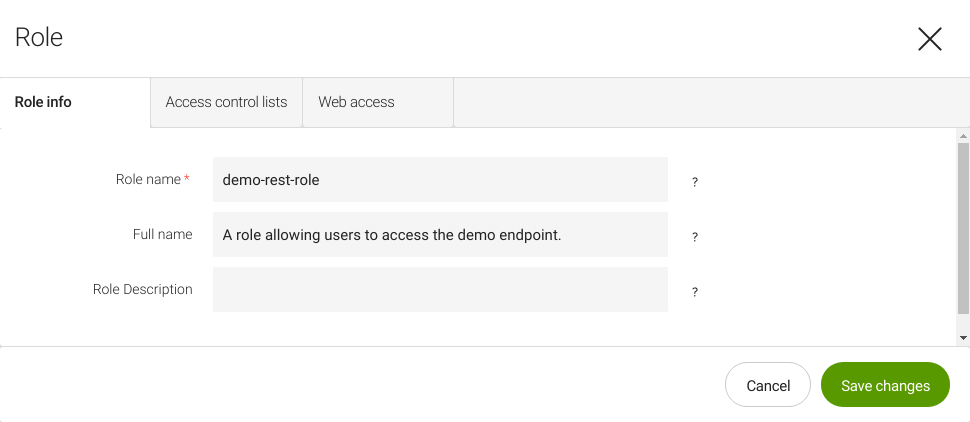
Access Control Lists (ACL):
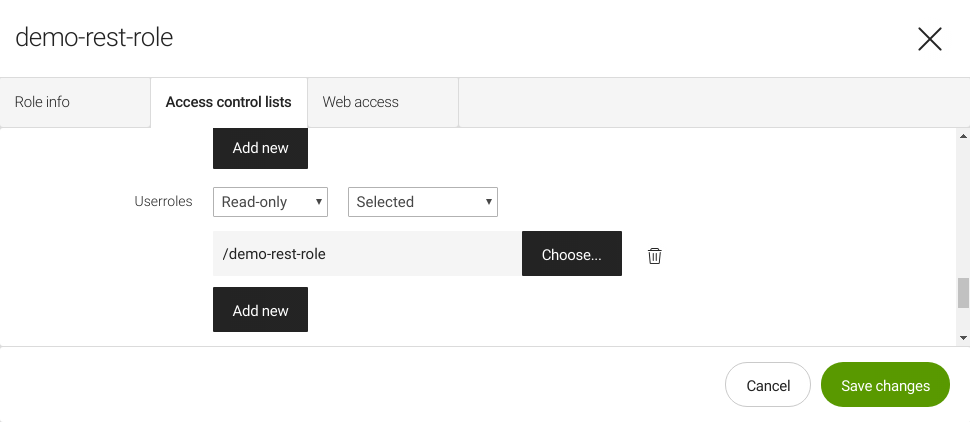
Web access:
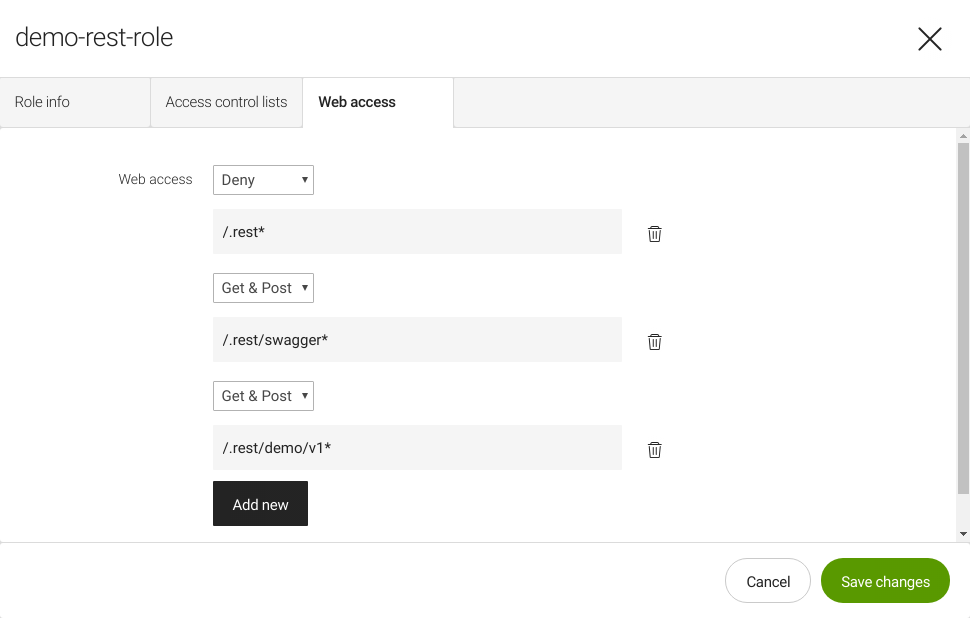
| Access Type | Path | Value | ||
|---|---|---|---|---|
Deny |
|
Deny all to begin. |
||
Get&Post |
|
Allow access to the Swagger tools. This is only required if you have the
|
||
Get&Post |
|
Allow access to our custom endpoint whose access path is
|
| Access type | Meaning |
|---|---|
Deny |
Everything is denied. |
Get |
Only the HTTP method |
Get&Post |
All HTTP methods available are allowed: |
This is the list of roles assigned to superuser:
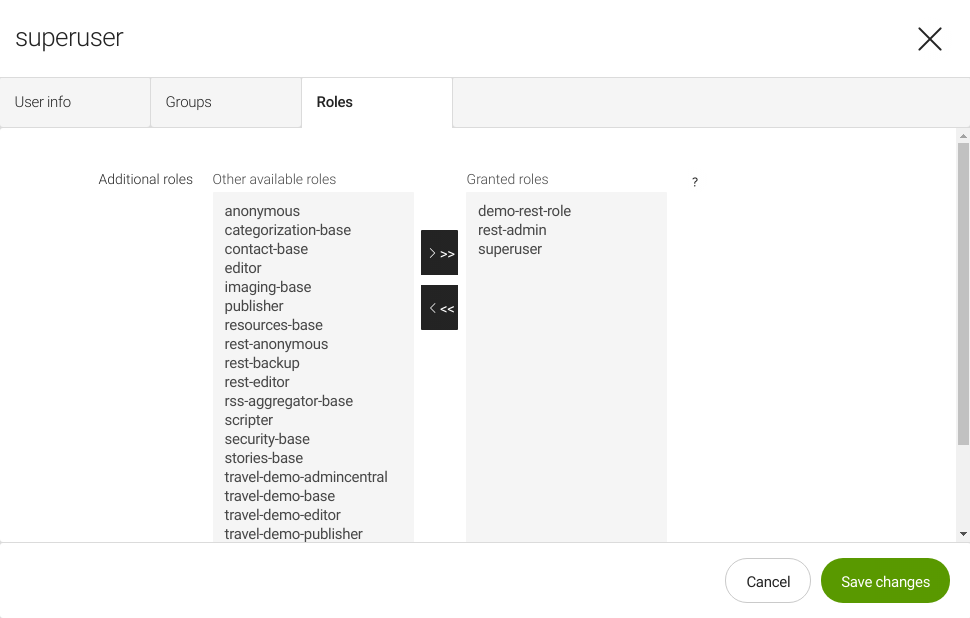
Depending on your bundle, you may have more roles assigned to
superuser.
Accessing the resource
Now everything is ready to access the custom endpoint.
Using cURL
cURL is a useful tool to test REST resources. To check if you have it installed, open a command shell and type:
curlWhen it is installed, the shell displays something like this:
curl: try 'curl --help' or 'curl --manual' for more informationOnce you have confirmed that cURL works, try the following request:
curl -i --user superuser:superuser -X GET --header 'Accept: application/json' 'http://localhost:8080/magnoliaAuthor/.rest/demo/v1/hello'Since we provide the -i option, cURL displays the response header.
Remember that the requested resource does not produce a payload, so
there is no response body.
HTTP/1.1 200 OK Server: Apache-Coyote/1.1 Set-Cookie: JSESSIONID=624D8A0283867F9FA07D02F72B9B72EA; Path=/magnoliaAuthor/; HttpOnly Pragma: no-cache Cache-Control: no-cache, no-store, must-revalidate, max-age=0 Expires: Thu, 01 Jan 1970 00:00:00 GMT Content-Type: text/html;charset=UTF-8 Content-Length: 0 Date: Tue, 04 Jul 2017 14:36:35 GMT
Now try to access the resource via the POST method:
curl -i --user superuser:superuser -X POST --header 'Accept: application/json' 'http://localhost:8080/magnoliaAuthor/.rest/demo/v1/hello'Here are the response headers:
HTTP/1.1 500 Internal Server Error Server: Apache-Coyote/1.1 Set-Cookie: JSESSIONID=C4A7CB1D1AA09967FD4E413E61D9AA4C; Path=/magnoliaAuthor/; HttpOnly Pragma: no-cache Cache-Control: no-cache, no-store, must-revalidate, max-age=0 Expires: Thu, 01 Jan 1970 00:00:00 GMT Content-Type: text/plain;charset=UTF-8 Content-Length: 79 Date: Tue, 04 Jul 2017 14:40:17 GMT Connection: close RESTEASY003650: No resource method found for POST, return 405 with Allow header
This is expected. The method #hello is annotated with
@GET
declaring it can only be accessed with the HTTP method GET. See the
section declaring the HTTP method.
|
Note that you pass the username and password in clear text in this cURL call. This is acceptable when testing on a local machine, however, we advise against doing this to access a production environment server. |
About marshalling and data conversion
An endpoint dealing with data must manage two types of data conversion:
-
Transforming data into a simple Java bean or POJO (Plain Old Java Object) and vice versa.
-
Transforming the POJO into JSON or XML and vice versa.
If the endpoint handles both read (GET) and write (PUT to create and POST to update) actions, marshalling and data conversion must also work in both directions.
In this section we focus on some aspects of this kind of data conversion.
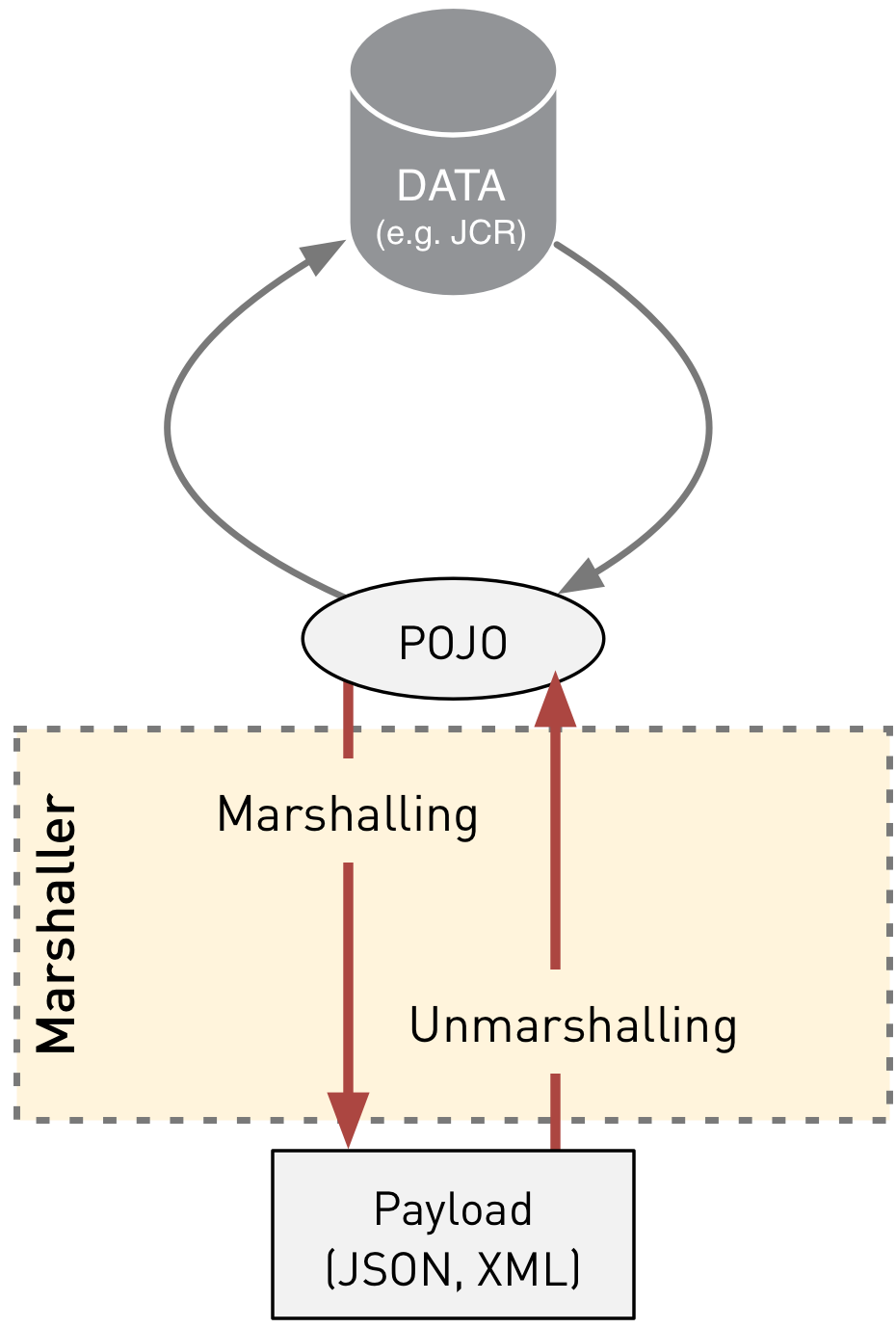
Converting a data object into a POJO and vice versa
Regardless of the type of data you deal with, in the context of a REST endpoint, at some point you typically transform data into a POJO (and vice versa).
There is no one size fits all for transforming a data object into a POJO and vice versa. The best solution for you depends on your use case.
JCR to POJO
The magnolia-rest-services module provides classes to transform JCR
nodes and properties into POJOs and vice versa.
-
info.magnolia.rest.service.node.v1.RepositoryMarshaller is the transformer.
-
info.magnolia.rest.service.node.v1.RepositoryNode is the type of the POJO.
The Magnolia endpoints info.magnolia.rest.service.property.v1.PropertyEndpoint and info.magnolia.rest.service.node.v1.NodeEndpoint use these classes. You also can use the classes for your custom endpoints. However, note that the structure of the POJO and of the resulting payload after marshalling may not cover your requirements.
Marshalling and unmarshalling - creating and receiving payload
Transforming a POJO into JSON or XML is known as marshalling. Transforming JSON or XML into a POJO is known as unmarshalling. Both processes are sometimes referred to as marshalling.
Marshalling is handled by the REST framework by the JAX-RS API implementation.
However, when dealing with payload (XML or JSON) in your endpoint, note the following:
-
To create payload, you must
PUTa POJO into the response of the endpoint method. -
When receiving payload from a request, the responsible method must have an appropriate signature in order to initiate unmarshalling.
Adding POJOs to the REST response to deliver payload
Imagine you have a POJO with the name Lunch and two properties: food
and beverage.
com.example.rest.pojos.Lunch
Now you require a method which can deliver a lunch payload. Endpoint
method(s) providing a Lunch object would look like this:
@Path("/lunch2")
@GET
@Produces({MediaType.APPLICATION_JSON})
public Response lunch2() {
Lunch pojo = new Lunch("Rösti mit Geschnetzeltem", "Ueli Weizen");
return Response.ok(pojo).build();
}
@Path("/lunch")
@GET
@Produces({MediaType.APPLICATION_JSON})
public Lunch lunch() {
Lunch pojo = new Lunch("Svíčková na smetaně ", "Gambrinus Plzen");
return pojo;
}
The seeming parallelism between
new Lunch("Rösti mit Geschnetzeltem", "Ueli Weizen"); and
new Lunch("Svíčková na smetaně ", "Gambrinus Plzen"); is no way
intended to present how to handle
internationalization.
|
The snippet shows two methods: #lunch and #lunch2. Both produce the
same payload when called from outside, however, their implementation is
slightly different.
#lunch2
-
Uses the generic return type
javax.ws.rs.core.Response. -
Puts the POJO (of the type
Lunch) into this response; see line 6. -
This approach provides high flexibility concerning the response code, for instance you can do things like this:
return Response.status(Response.Status.NOT_ACCEPTABLE).build(); //... return Response.status(Response.Status.BAD_REQUEST).build();
#lunch
-
Uses the specific POJO as return type. Here it is
com.example.rest.pojos.Lunch. -
Returns the POJO directly on the method.
Note that both method produce the same response headers and identical payload (structure, in this example only the values of the food and beverage properties differ).
#lunch2
curl -i --user superuser:superuser -X GET --header 'Accept: application/json' 'http://localhost:8080/magnoliaAuthor/.rest/demo/v1/lunch2'
HTTP/1.1 200 OK
Server: Apache-Coyote/1.1
Set-Cookie: JSESSIONID=427FFB4FD60492BDD7D8C76E28F91222; Path=/magnoliaAuthor/; HttpOnly
Pragma: no-cache
Cache-Control: no-cache, no-store, must-revalidate, max-age=0
Expires: Thu, 01 Jan 1970 00:00:00 GMT
Content-Type: application/json;charset=UTF-8
Content-Length: 61
Date: Wed, 05 Jul 2017 16:48:53 GMT
{"id":"b8a3da44-35cf-48a5-9f69-dc38bff881da","food":"Rösti mit Geschnetzeltem","beverage":"Ueli Weizen"}
#lunch
curl -i --user superuser:superuser -X GET --header 'Accept: application/json' 'http://localhost:8080/magnoliaAuthor/.rest/demo/v1/lunch'
HTTP/1.1 200 OK
Server: Apache-Coyote/1.1
Set-Cookie: JSESSIONID=8842AE5F355D4E4E188587483B6B0B52; Path=/magnoliaAuthor/; HttpOnly
Pragma: no-cache
Cache-Control: no-cache, no-store, must-revalidate, max-age=0
Expires: Thu, 01 Jan 1970 00:00:00 GMT
Content-Type: application/json;charset=UTF-8
Content-Length: 64
Date: Wed, 05 Jul 2017 16:51:29 GMT
{"id":"17f552a0-11e8-4d5d-898b-ecf17f05b1ba","food":"Svíčková na smetaně ","beverage":"Gambrinus Plzen"}
Note that the payload also contains the property id. This property
comes from the super class com.example.rest.pojos.BasicStorable of
Lunch; we will need this id later on.
Both approaches to produce payload with POJOs shown here work in more complex scenarios. For example: you could return a list of POJOs; the properties of the POJO could also be POJOs; and so on.
Receiving payload and getting the POJO
Endpoint methods that receive a payload (JSON or XML) are typically used to create or update an object.
Let’s imagine an example where the endpoint allows you add a lunch
object to a store. In the context of a data store, adding is like
creating. To create an object, a REST service is called with the the
HTTP method PUT.
This code snippet shows the method to add a lunch:
com.example.rest.service.v1.DemoEndpoint#storeLunch
-
Line 140: It is generally considered good practice to tell the service what type of data it consumes. However, it is not required.
-
Line 143: The most important point in the current context is the method signature.
The method must contain a parameter of the type to which the payload should be mapped to. -
Line 146: If the mapping was successful, we add the lunch POJO to the store. The
storeactually is a mock store, it does not really store data in the example. (SeeBlackboxDatastore.javaon Git). However,store#addmay throw an exception if it fails. -
Line 147: Build the response with the response code 200 (ok), and also put the lunch object into the payload, it now carries the object id too. Giving back the just created object could be used on a client to render an update UI or to summarize the successful add action.
-
Line 148-150: These lines handle the exception thrown by the store. You can provoke this by sending a payload to the method where the property
foodhas the valueBad food.
You can test the new method using cURL.
curl -i http://localhost:8080/magnoliaAuthor/.rest/demo/v1/store-lunch \
-H "Accept: application/json" \
-H "Content-Type: application/json" \
-X PUT \
--user superuser:superuser \
--data \
'{"food": "Pizza Napoli", "beverage": "Birra Moretti"}'
HTTP/1.1 200 OK
^Server: Apache-Coyote/1.1
Set-Cookie: JSESSIONID=7E99151D9036CDA5DC200BA8FE70EACB; Path=/magnoliaAuthor/; HttpOnly
Pragma: no-cache
Cache-Control: no-cache, no-store, must-revalidate, max-age=0
Expires: Thu, 01 Jan 1970 00:00:00 GMT
Content-Type: application/json;charset=UTF-8
Content-Length: 94
Date: Thu, 06 Jul 2017 16:33:04 GMT
{"id":"b64633b7-4555-4571-86b6-8e45bdab61b3","food":"Pizza Napoli","beverage":"Birra Moretti"}
The first attempt was successful! :smile:
Now provoke an error with Bad food:
curl -i http://localhost:8080/magnoliaAuthor/.rest/demo/v1/store-lunch \
-H "Accept: application/json" \
-H "Content-Type: application/json" \
-X PUT \
--user superuser:superuser \
--data \
'{ "food": "Bad food", "beverage": "Bud Light"}'
HTTP/1.1 406 Not Acceptable
Server: Apache-Coyote/1.1
Set-Cookie: JSESSIONID=FEA3475D150D8106F8A265E97060BC2F; Path=/magnoliaAuthor/; HttpOnly
Pragma: no-cache
Cache-Control: no-cache, no-store, must-revalidate, max-age=0
Expires: Thu, 01 Jan 1970 00:00:00 GMT
Content-Length: 0
Date: Thu, 06 Jul 2017 16:36:15 GMT
The Bad food was rejected. No payload was returned and the HTTP
response code is 406 (Not Acceptable).
Implementing a method to update an object (and using the HTTP method
POST) works in a similar way. In such a case, the payload sent to the
REST endpoint must contain the object id in order to update the correct
item on the data store.
The same-origin policy problem
Let’s assume you want to use a data API endpoint to serve content
managed with Magnolia apps to independent applications located
outside of Magnolia. For example, you want to use an AngularJS
application to display your content.
We also assume Magnolia and the Angular application are hosted on
completely different systems.
- According to the same-origin policy
(…) a web browser permits scripts contained in a first web page to access data in a second web page, but only if both web pages have the same origin.
Therefore, if your application resides within a domain that is different from the domain that hosts your data, the web browser will actively prevent accessing content stored under the host domain.
An elegant solution to solve the same-origin policy without changing Apache configuration is the Magnolia Add HTTP Headers filter. This filter is available out-of-the-box; you only need to configure it.
Sample code on Git
The sample code for the examples on this page is available on the Magnolia Git repository.